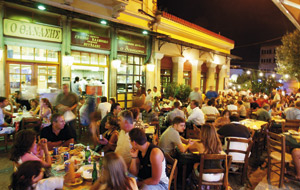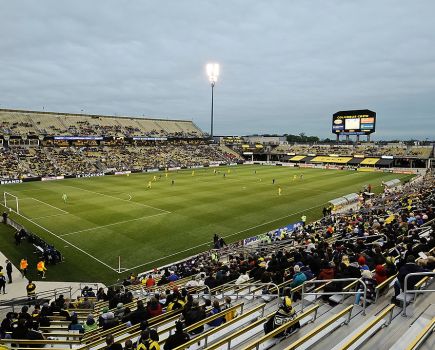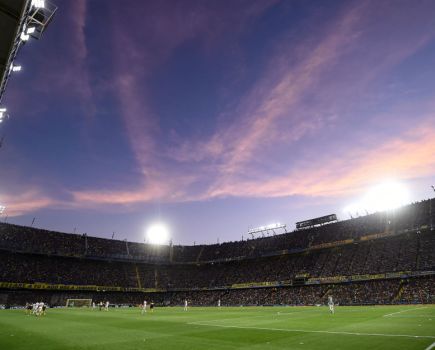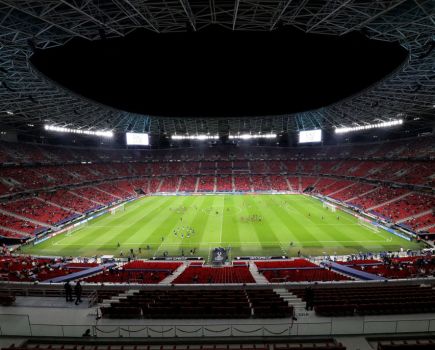ATHENS
The setting for the 2007 Champions League Final could not have been better. Athens’ Olympic stadium had a complete overhaul for the 2004 Games under renowned Spanish architect Santiago Calatrava and now has a capacity of over 70,000. It currently hosts most league home games of Panathinaikos and AEK, two of Greece’s big three clubs.
The other one, Olympiakos, the most successful club in the country in recent years, are based at the Yorgos Karaiskakis stadium in the nearby port of Piraeus. That ground was also revamped for 2004.
Olympiakos, known as Gavri (little fish), have just won the league title for the 10th time in 11 seasons. But while the club, backed by mobile-phone millionaire Sokratis Kokkalis and with ex-player Takis Lemonis as coach, have domestic dominance, they have failed to make much of an impact in European competition.
Olympiakos, formed in 1925, are also known as Thrylos (legend) after their famous original five-man forward line, the Andrianopoulos brothers. After helping the team lift four of the first six Greek titles, the quintet persuaded the Greek Olympic Committee to convert an old velodrome used for the first modern Olympics of 1896 into an athletics and football ground. In 2004, the last surviving brother, 94-year-old Leonidas, lit the flame for the Olympic torch relay at Piraeus.
Traditionally, the club draw their support from the blue-collar port workers – in contrast to Panathinaikos, whose permanent base is in the wealthy area of Ambelokipi, in the north-west of Athens.
Shamrock badgePanathinaikos, Greece’s oldest club, having been founded in 1908, wear green and bear a shamrock badge but there is no connection with Ireland. The emblem was adopted on the suggestion of a Greek athlete. Pana have used the Apostolos Nikolaidis stadium, close to Ambelokipi station, since its construction in 1922 but because it is only modest they have been playing nearly all home games at the Olympic stadium for more than 20 years.
A new ground has been discussed for years but despite the club’s white-collar image, funds have not been forthcoming.
Games between Panathinaikos and Olympiakos are the biggest in Greek sport. Recently all team sports in the country were suspended for a fortnight after supporters from these rival clubs clashed in the distant Athenian suburb of Peania in the run-up to a women’s volleyball fixture. There was one fatality. In 1995, clashes after a basketball game between the clubs also led to the death of a fan.
Greek sport has been blighted by fan violence for years. There is no ticket allocation for the visiting club for derby matches. This latest incident has prompted the authorities to start installing CCTV cameras at grounds.
AEK’s traditional base is in Nea Filadelfia, in northern Athens, close to that of Panathinaikos. Their Nikos Goumas stadium was hit by an earthquake in 1996 and demolished in 2003. The club are planning a modern, multi-sports arena in the same locality.
AEK were formed in 1924 by Greek refugees fleeing Constantinople after Turkish independence – hence the club’s Byzantine double-headed eagle emblem. AEK have a particularly bitter rivalry with Olympiakos because the Piraeus club poached their mercurial coach, Dusan Bajevic, in 1996 to begin their run of domestic title success.
Bajevic returned to oversee AEK’s Champions League campaign of 2002. Ambitious young president Demis Nikolaidis, the former international and an AEK fan from boyhood, took control in 2004, assuming their massive debt. Season ticket sales for games at the Olympic stadium are healthy and the yellow-and-blacks are Champions League regulars.
Stadiums
 The new, rebuilt Olympiako Stadio Athinas Spyros Louis (37 Kifissias, Maroussi; +30 210 683 4060 or 4061) was inaugurated days before the official opening of the 2004 Olympic Games. The two-year reconstruction, under renowned Spanish architect Santiago Calatrava, cost £175million. Its main features are the twin arches, spanning 304 metres and rising to 72 metres, which support the stylish, functional polycarbonate roof. The stadium, part of a complex that includes a pool, indoor arena and velodrome, dominates Maroussi, a northern suburb 9km from the city centre.
The new, rebuilt Olympiako Stadio Athinas Spyros Louis (37 Kifissias, Maroussi; +30 210 683 4060 or 4061) was inaugurated days before the official opening of the 2004 Olympic Games. The two-year reconstruction, under renowned Spanish architect Santiago Calatrava, cost £175million. Its main features are the twin arches, spanning 304 metres and rising to 72 metres, which support the stylish, functional polycarbonate roof. The stadium, part of a complex that includes a pool, indoor arena and velodrome, dominates Maroussi, a northern suburb 9km from the city centre.
The original ground, opened in 1982, was constructed on a site dotted with classical antiquities – Roman baths were discovered during the rebuild. Spyros Louis, the winner of the marathon at the first modern Olympics, in 1896, was a Maroussi local. The stadium hosted two European Cup finals and many big domestic fixtures before closure for reconstruction in 2002.
Calatrava’s impressive creation consists of two rings of seating, divided into 35 sections. Capacity is 71,030. The nearest metro station is Irini on green line 1, a 10-minute walk. The journey time from central Omonio is 25 minutes. Near Irini is the railway station of Neratziotissa, linked to Doukissis Plakentias metro station, which is within easy reach of the airport.
There are three main ticket offices in the complex: one right by Irini metro, one on Kimis nearby, and one behind the east goal.You can arrange a group tour of the complex (€3/£2 per person) by fax on +30 210 683 4021. For more information, phone +30 210 683 4777.
The other main stadium in town is Yorgos Karaiskakis, in Piraeus, home of Olympiakos. Therenovated arena was originally built as a velodrome for the 1896 Olympics, converted for football in 1936 and refurbished in the 1960s. Chelsea won the European Cup-Winners Cup there in 1971. There was a stadium tragedy in 1981 – 21 fans died during a crush at an Olympiakos-AEK Athens match. Banners are still displayed at every match to honour the victims.
The stadium, accessed from the Faliro metro station on green line 1, holds 33,000. There is now a club museum (closed Mondays).
Survival Guide
Arrival & transport
Athens’ airport is 27km east of the city centre. Metro line 3 links with the central Syntagma station – journey time 30 minutes, one-way ticket €6 (£4). The second stop from the airport, Doukissis Plakentias, connects to the suburban railway line (Proastiakos; top picture) up to Neratziotissa, close to the Olympic stadium.
An airport express bus, the X95, runs to Syntagma Square (journey time 70 minutes) round the clock. A one-way ticket costs €3.20 (£2.15). A taxi should cost €20-30 (£13-20).Central Athens is served by a three-line metro system. A single ticket is €1 (70p). There are also buses and trolleybuses. A one-day ticket (€3/£2) allows travel on most public transport.
The city’s yellow taxis can be flagged down or hired at the rank at Syntagma near Ermou.
Hotels
The Greek tourism organisation (main Athens office at 7 Tsoha, Ambelokipi; +30 210 870 7000) offers information on accommodation.
One of the smarter hotels, at €200 (£135) per double room per night, is the centrally located Electra Palace (18-20 N. Nikodimou; +30 210 337 0000). The mid-range Hera (9 Falirou; +30 210 923 6682) and Plaka (7 Kapnikareas & Mitropoleos; +30 210 322 2706 or 2707), both around €150 (£100), are also conveniently situated. Budget options include the €85 (£60) Adonis (3 Kodrou & Voulis; +30 210 324 9737) near Syntagma and the €60 (£40) Fivos (23 Athinas; +30 210 322 6657)
The Greeks eat late and traditional tavernas are still the mainstay – Athinaikon (2 Themistokleous, Omonia Square), Giouvetsakia (144 Adrianou, Plaka) and To Steki tou Ilia (7 Thessalonikis, Thissio) are three fine examples. Terrace cafes in Thissio, Kolonaki and Plaka throng with locals. Aplakafe (1 Adrianou) and Athinaion Politeia (1 Akamantos) both have great views of the Acropolis.
Daytime entertainment
The Acropolis, one of the wonders of the Ancient World, is a collection of temples and monuments, with the Parthenon as its figurehead. Below, Plaka, with its market, spreads across what was the centre of the old city. The National Archaeological Museum, Byzantine Museum and Benaki Museum are the other must-sees.
After dark
The hub of the thriving nightlife scene is in Psyrri, the other side of Ermou from Plaka.








